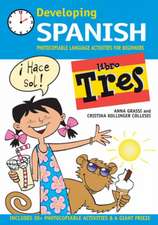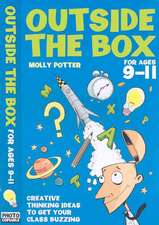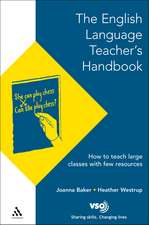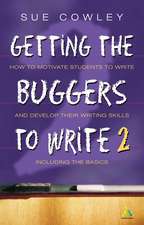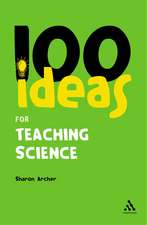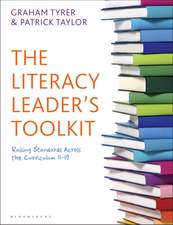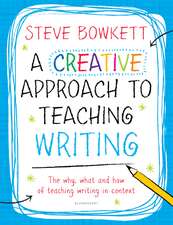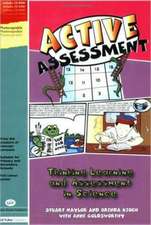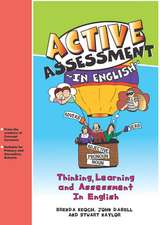Mathematics Education with Digital Technology
Editat de Adrian Oldknow, Carol Knights Sue Brindleyen Limba Engleză Paperback – 8 mai 2013
| Toate formatele și edițiile | Preț | Express |
|---|---|---|
| Paperback (1) | 265.93 lei 6-8 săpt. | |
| Bloomsbury Publishing – 8 mai 2013 | 265.93 lei 6-8 săpt. | |
| Hardback (1) | 1066.72 lei 6-8 săpt. | |
| Bloomsbury Publishing – iun 2011 | 1066.72 lei 6-8 săpt. |
Preț: 265.93 lei
Preț vechi: 303.89 lei
-12% Nou
Puncte Express: 399
Preț estimativ în valută:
50.89€ • 53.26$ • 42.35£
50.89€ • 53.26$ • 42.35£
Carte tipărită la comandă
Livrare economică 31 martie-14 aprilie
Preluare comenzi: 021 569.72.76
Specificații
ISBN-13: 9780567250285
ISBN-10: 0567250288
Pagini: 304
Ilustrații: 112
Dimensiuni: 156 x 234 x 18 mm
Greutate: 0.45 kg
Editura: Bloomsbury Publishing
Colecția Bloomsbury Academic
Locul publicării:London, United Kingdom
ISBN-10: 0567250288
Pagini: 304
Ilustrații: 112
Dimensiuni: 156 x 234 x 18 mm
Greutate: 0.45 kg
Editura: Bloomsbury Publishing
Colecția Bloomsbury Academic
Locul publicării:London, United Kingdom
Caracteristici
Considers how to maximise use of digital technologies to benefit teaching and learning mathematics.
Notă biografică
Adrian Oldknow is Emeritus Professor of Mathematics and Computer Education at the University of Chichester, UK. Carol Knights is Principal Lecturer in Mathematics Education at the University of Chichester, UK.
Cuprins
Notes on ContributorsSeries Editor's ForewordAcknowledgementsIntroductionPart 1: Where Are We Now? 1. The NeuroScience of Connections, Generalizations, Visualizations and Meaning Edward D. Laughbaum 2. ICT in the United States: Where We Are Today and a Possibility for Tomorrow Gail Burrill 3. ICT in France: Development of Usages, Institutional Hesitations and Research Questions Luc Trouche and Ghislaine Gueudet 4. ICT and the English Mathematics Curriculum Sue Pope Part 2: What Does Research Tell Us? 5. The Value of Learning Geometry with ICT: Lessons from Innovative Educational Research Keith Jones 6. Learning Mathematics Using Digital Resources: Impacts on Learning and Teaching for 11- to 14-year old Pupils Don Passey 7. Improving on Expectations: Preliminary Results from Using Network-supported Function-based Algebra Walter Stroup, Lupita Carmona and Sarah M. DavisPart 3: Key Pedagogical Issues in Embedding ICT in Teaching and Learning Mathematics 8. Designing Substantial Tasks to Utilize ICT in Mathematics Lessons Colette Laborde 9. Learning from Acting on Objects John Mason 10. A Case Study of Using Multiple Resources to Teach Straight Line Graphs Rosemary Deaney and Sarah Hennessy Part 4: Description of a Range of ICT Tools 11. Emerging Technologies for Learning and Teaching Vanessa Pittard 12. Home and School - Bridging the Gap Russell Prue 13. Personal Portable Technology Adrian Oldknow and Peter Hamilton Part 5: Practical Ideas of ICT to Enhance Teaching and Learning 14. Linking the Mathematics Curriculum to Software, Resources and Strategies to Engage Teachers and Learners in Using ICT in the Classroom Linda Tetlow 15. The Uses of Online Resources for Teaching and Learning Mathematics at Advanced Level Bryan Dye 16. What Do the Subject Associations Offer? Ruth Tanner 17. Modelling, Functions and Estimation: A Pizza Problem Chris Olley Part 6: ICT Supporting Cross-curricular Work with Mathematics 18. Using Video Analysis to Develop Modelling Skills in Physics Steve Hearn 19. Bloodhound SSC: A Vehicle for STEM Ian Galloway 20. Modelling Action in Sports and Leisure Matt Pauling and Adrian Oldknow Part 7: Case Studies of Teachers Engaging with ICT 21. Teaching International Baccalaureate Mathematics with Technology Jim Fensom 22. Why Use Technology to Teach Mathematics? Andy Kemp 23. Using ICT to Support Learning Mathematics in the Primary Classroom Mel Bradford and Tina Davidson 24. The Role of a Head of Mathematics Department in Ensuring ICT Provision and Use within Lessons Dawn Denyer and Carol Knights 25. Developing Problem Solving Skills and Cross-curricular Approaches in Mathematics Utilizing ICT Michael Hartnell and Carol Knights Part 8: Implications for Professional Development 26. Supporting Developments within a Local Authority Ron Taylor 27. Supporting Teachers in Introducing New Technologies Alison Clark-Wilson 28. Implications for Professional Development: Supporting Individuals Pip Huyton 29. What Are the Significant Factors Which Support the Integration of ICT in the Mathematics Classroom? David Wright and Pat WoolnerGlossary Index
Recenzii
'This is an exciting book that draws on the expertise of a wide range of contributors from across the globe and from both research and classroom backgrounds. It is thought-provoking and challenging. It covers a diverse range of types of ICT use all of which illustrate the potential of ICT to enhance the learning and teaching of mathematics. I hope with the help of books like this one we can move the agenda forward and bring ICT to all our students.' Celia Hoyles OBE, Professor of Mathematics Education, University of London, UK, and Director of the National Centre for Excellence in the Teaching of Mathematics, UK
Mathematics Education with Digital Technology will be of interest to those involved in the training of teachers and in the development of mathematics curricula.
Mathematics Education with Digital Technology will be of interest to those involved in the training of teachers and in the development of mathematics curricula.

